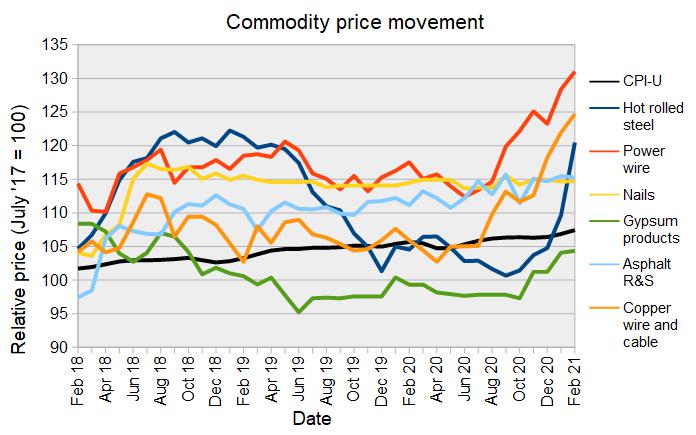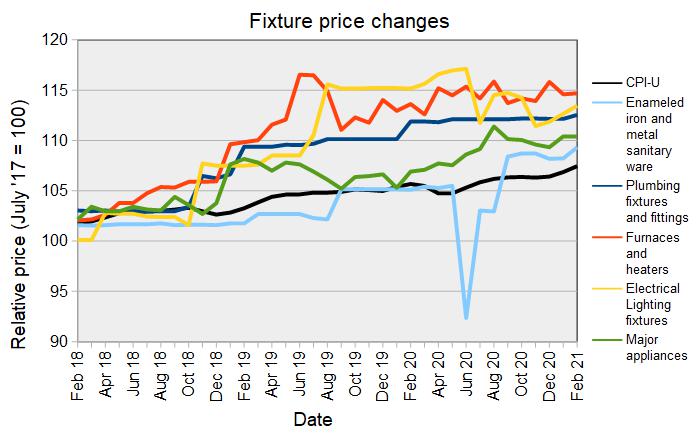The Bureau of Labor Statistics (BLS) released its producer price index report for February 2021. It showed that the BLS price index of materials and components for construction was up 1.4 percent in the month, seasonally adjusted. This follows on the heels of a 1.5 percent increase in December. The index was 8.0 percent higher than its year-earlier level, with more of the materials we track seeing double digit price increases for the year.
Overall prices for processed goods for intermediate demand rose by 2.7 percent. The index was 6.6 percent higher than its year-ago level.
For reference, the changes in these indices compare with a 1.7 percent rise in the all-items consumer price index (CPI-U) for the 12 months ending in February. The CPI-U was up 0.4 percent for the month.
Yield Pro (PRO) compiled the BLS reported price changes for our standard list of construction commodities. These are commodities whose prices directly impact the cost of constructing an apartment building. The two right hand columns of the table provide the percent change in the price of the commodity from a year earlier (12 Mo PC Change) and the percent change in price from January 2021 (1 Mo PC Change). If no price data is available for a given commodity, the change is listed as N/A.
| Commodity |
12 Mo PC Change |
1 Mo PC Change |
Softwood lumber |
79.7 |
7.9 |
Hardwood lumber |
16.9 |
2.5 |
General millworks |
3.6 |
0.3 |
Soft plywood products |
87.0 |
11.9 |
Hot rolled steel bars, plates and structural shapes |
15.2 |
9.9 |
Copper wire and cable |
18.2 |
2.2 |
Power wire and cable |
11.8 |
2.1 |
Builder’s hardware |
1.3 |
1.0 |
Plumbing fixtures and fittings |
0.6 |
0.4 |
Enameled iron and metal sanitary ware |
4.0 |
1.0 |
Furnaces and heaters |
0.8 |
0.1 |
Sheet metal products |
2.2 |
2.6 |
Electrical Lighting fixtures |
-1.7 |
0.7 |
Nails |
0.4 |
0.1 |
Major appliances |
2.9 |
0.0 |
Flat glass |
2.3 |
-0.5 |
Ready mix concrete |
0.8 |
0.3 |
Asphalt roofing and siding |
3.7 |
-0.2 |
Gypsum products |
5.1 |
0.3 |
Mineral wool insulation |
7.0 |
3.1 |
Lumber prices were up again in February as is shown in the first chart, below. The Random Length Lumber continuous contract price breached the $1000 level in mid-February, closing at $1021.80 on February 22. However, the continuous contract price has been retreating since then, reaching $862 on March 15.
By contrast, the 2018 run-up in lumber prices peaked in May of that year at $624.
Lumber futures prices remain close to where they were last month with the contract for May 2021 delivery trading around $860. The contract for March 2022 delivery is trading near $700.
The price of soft plywood products followed that of framing lumber higher this month. The BLS reported that its price was up nearly 12 percent for the month and 87 percent for the year. Both of these percentage increases exceed those for framing lumber.
According to Madison’s Lumber Reporter, lumber production in the US was up 4.3 percent in 2020 from its year-earlier level. This is despite the disruptions to production in the spring as the pandemic inspired shutdowns were imposed. However, production was down in Canada in 2020, leaving the production total for the two countries up only about 1 percent for the year. 
The next chart, below, shows the recent price history of several other construction materials. Copper wire and power wire have been moving higher over the last few months. This month the price of steel also moved sharply higher.
The price of copper, rose in February, peaking at $4.33 per pound on February 25. This was after trading in the $3.50 to $3.60 per pound range for most of December and January. Copper futures prices have moved up in line with the spot price.
The price of aluminum also rose in February, reaching a peak on February 23. Its price is down slightly since then but is still about 23 percent higher than at the end of 2019.
The price of steel crashed when the pandemic hit one year ago. It began a steady recovery during the summer months and surged higher starting in November 2020. The BLS reports that the price of steel rose nearly 10 percent in February. MarketWatch reports that steel is now trading over 40 percent higher than its price at the end of 2019. Steel futures indicate that the price will remain strong into the summer but may ease later in the year.
The prices of most other commodities tracked in this chart have been relatively stable despite the market disruptions caused by COVID-19.
Price changes for several of the more finished goods from our sample are illustrated in the final chart, below. The prices of these items seem to be continuing their recent trend of growing at a rate that is slightly above the general rate of inflation in the economy.
The full BLS report can be found here.













